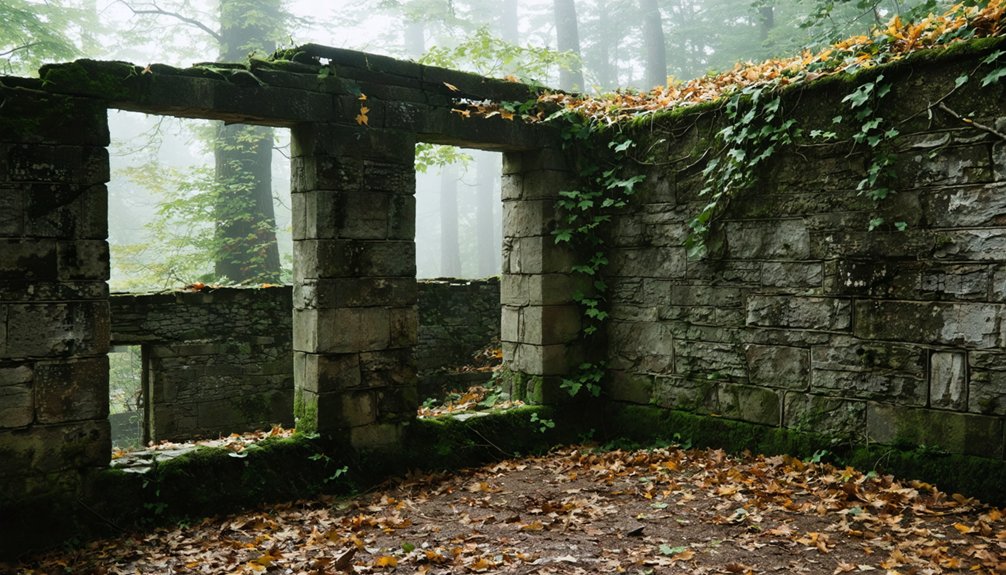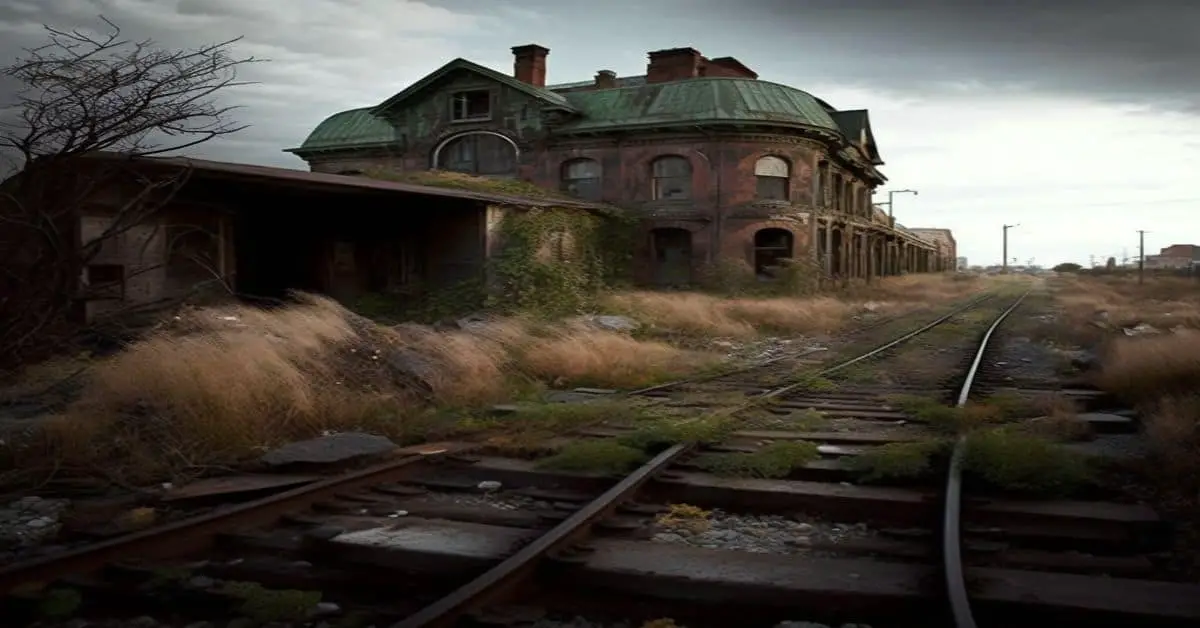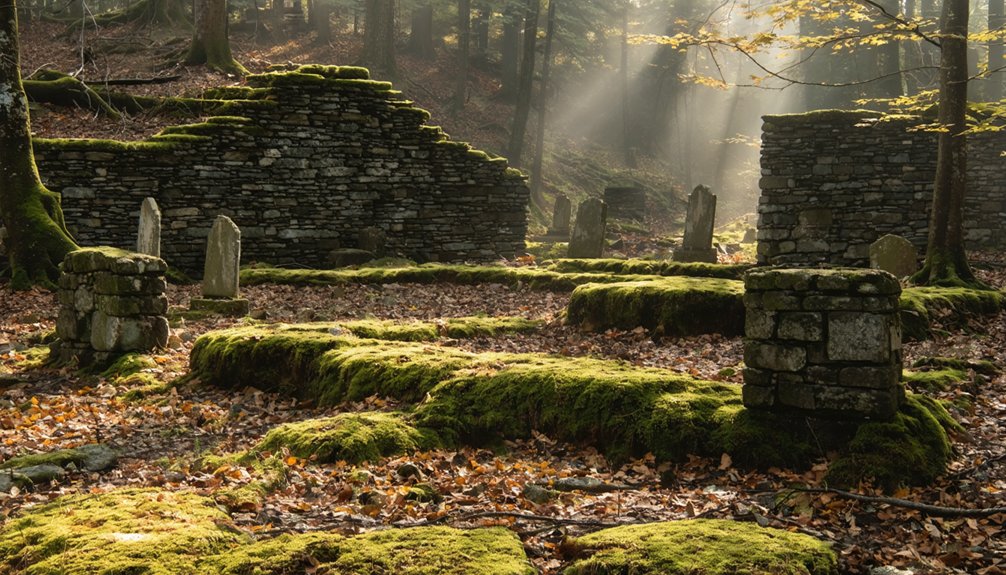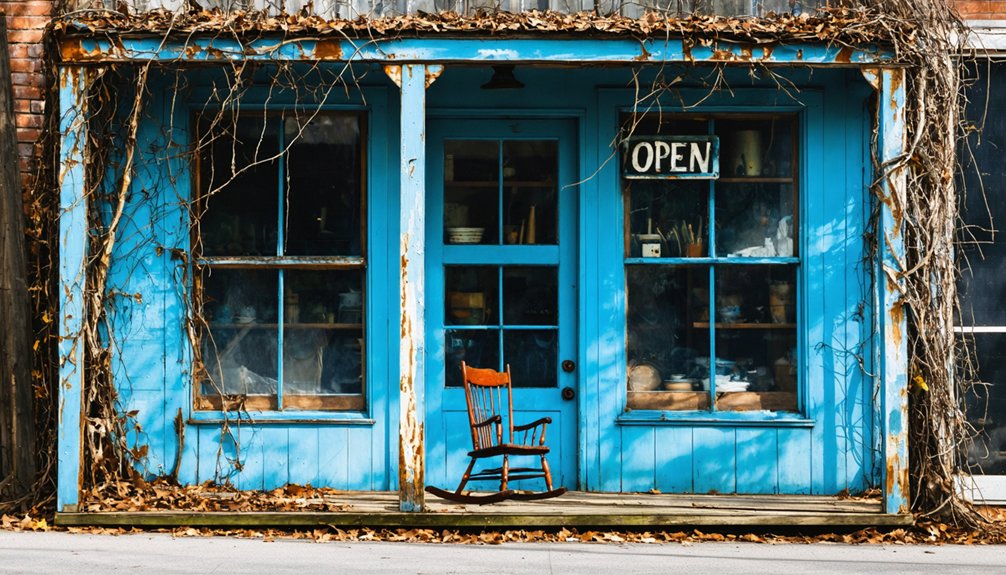You’ll find the haunting ruins of Gay City State Park in Connecticut, where a Methodist settlement established in 1796 once thrived as Factory Hollow. The community grew around wool mills along the Blackledge River but faced devastation from multiple fires, economic struggles, and mysterious deaths. Today, you can explore the 1,569-acre park’s stone foundations, historic cemetery, and 21 miles of trails, where centuries of dark tales and unexplained encounters await.
Key Takeaways
- Gay City was established in 1796 by Methodist followers seeking isolation, initially named Factory Hollow before becoming a ghost town.
- The settlement thrived around water-powered mills but declined after multiple fires, including a devastating mill fire in 1830.
- Remnants of the ghost town are preserved within Gay City State Park’s 1,569 acres, including building foundations and historic graveyards.
- The community’s downfall stemmed from economic challenges during the War of 1812 and subsequent fires that destroyed vital industrial facilities.
- Local folklore includes tales of mysterious deaths, unexplained fires, and reported paranormal activity around the abandoned settlement’s ruins.
The Birth of a Religious Settlement (1796)
When religious discord erupted in Hartford in 1796, Elijah Andrus led a group of Methodist followers to establish a secluded settlement that would later become known as Gay City.
You’ll find that religious dissent from Hartford’s Congregationalist establishment drove these devout settlers to seek their own path, with Rev. Henry P. Sumner joining Andrus in leadership.
Initially called Factory Hollow, the settlement embodied the founders’ desire for community isolation. They built their homes from locally sourced timber along the Blackledge River, creating a self-contained village in the hollow between Hebron and Bolton. The first water-powered mill was constructed around 1800, marking the beginning of the settlement’s industrial development.
Nestled between Hebron and Bolton, Factory Hollow arose as a secluded sanctuary along the Blackledge River, built from local timber.
The founding families, determined to practice their faith freely, established a strict social order with mandatory twice-weekly religious services. Their quest for independence would shape the settlement’s early years and set the stage for its unique development. The community grew to include approximately twenty-five families, mostly members of the prominent Gay family.
Rise and Fall of Factory Hollow’s Industry
You’ll find the origins of Factory Hollow’s industrial era in its 1810 wool mill, established by William Strong and powered by the Blackledge River’s waters through an overshot wheel system.
The mill drew its water from Still Pond through a lengthy race system that fed its operations.
Similar to Factory Hollow’s experience, Roaring Brook powered numerous mills throughout Connecticut’s manufacturing history.
The War of 1812 struck a devastating blow to the initial industrial success, leading to mill ownership changes and eventual destruction by fire in 1830.
After the fire, many families migrated to urban centers, marking the beginning of Factory Hollow’s decline, though later attempts at industrial revival through a paper mill operation would also end in flames after the Civil War.
Early Mill Operations
The rumble of ox-drawn sledges marked the beginning of Factory Hollow’s industrial era in 1804, as massive foundation stones were transported to the chosen mill site along the Blackledge River.
You’ll find that William Strong and Company established sophisticated water management systems to power their wool production operations by 1810, including an overshot water wheel fed by a carefully engineered canal from Still Pond. Unfortunately, the mill’s success was short-lived when a devastating fire in 1830 brought woolen cloth production to a permanent end. The town’s early prosperity was bolstered by a local distillery established in 1811.
The mill’s industrial capabilities included:
- A primary woolen cloth manufacturing facility on the river’s east side
- An integrated sawmill operation to diversify production
- An extensive network of head and tail races for water flow control
This industrial complex transformed the village’s economy, drawing workers from neighboring communities and establishing crucial trade connections with Hartford’s markets for both raw materials and finished goods.
War’s Economic Impact
Despite initial industrial promise, Factory Hollow‘s woolen mill operations ground to a halt during the War of 1812, marking the beginning of decades of economic instability.
The war economy disrupted crucial trade routes and supply chains, devastating William Strong’s wool mill operations. Similar to Factory Hollow’s decline, post-Civil War shifts forced many Amherst mills to close or relocate to larger industrial centers.
However, competition between prominent families like the Gays and Sumners complicated the town’s economic recovery. The intense competition mirrored the devastating effects of the business panic of 1873 that crippled many industrial operations across the region.
You’ll find that post-war recovery efforts showed signs of industrial resilience, with Henry P. Sumner’s Lafayette Manufacturing Company taking over the failed mill’s infrastructure.
The war’s lasting impact created a pattern of boom-and-bust cycles, leading to population decline as workers sought opportunities in urban mill cities.
When fire destroyed the mill in 1830, it accelerated Factory Hollow’s transformation into a ghost town.
Industrial Decline Era
As Factory Hollow emerged around 1810, William Strong and Company’s woolen mill operation established itself as the village’s economic cornerstone, sourcing wool from local sheep farms and supplying cloth to Hartford merchants.
The village’s industrial heritage reveals a pattern of initial success followed by devastating setbacks that would ultimately lead to its abandonment. Preservation Connecticut now works to document and protect such historically significant industrial sites across the state.
- The War of 1812’s British blockade disrupted trade, forcing the original mill into failure
- Lafayette Manufacturing Company’s catastrophic fire in 1830 ended wool production permanently
- Dr. Sumner’s paper mill brought brief revival until its destruction by fire in 1879
You’ll find that Factory Hollow, like many forgotten communities of rural New England, couldn’t sustain itself as younger generations sought urban opportunities. The rise of telephone exchanges across New England further isolated communities that lacked modern communication infrastructure.
The Civil War’s population drain, combined with industrial stagnation and isolation from major markets, sealed the village’s fate.
Dark Tales and Paranormal Encounters
You’ll find disturbing accounts of mysterious deaths at Gay City’s mills, where multiple fires claimed lives under suspicious circumstances and left questions that remain unanswered today.
The most chilling tale involves a town blacksmith who allegedly beheaded his apprentice for tardiness, with witnesses still reporting sightings of a headless figure running through the woods near the ruins.
The discovery of skeletal remains in a charcoal pit and elsewhere among the ruins has only strengthened the site’s reputation for paranormal activity, drawing investigators who capture unusual phenomena on their equipment.
Unexplained Mill Fire Deaths
While no official records document deaths from Gay City‘s mill fires, local folklore weaves tales of supernatural encounters around these industrial tragedies.
You’ll find the most persistent mill mysteries center on the three devastating fires that struck between 1830 and 1879, though historical research reveals no evidence of fatalities.
- The woolen mill’s destruction in 1830 sparked the first wave of fire folklore, as departing residents shared stories of unexplained phenomena.
- The post-Civil War paper mill fire added another layer of mystery to the site’s reputation.
- The final 1879 blaze, which sealed Gay City’s fate, remains a source of ghostly speculation.
Despite numerous paranormal claims near the mill ruins, you won’t find documented proof connecting any spectral activity to actual fire-related deaths.
Blacksmith’s Ghost Haunts Ruins
Beyond the mill fires that shaped Gay City‘s decline, an even darker legend haunts the ruins of this Connecticut ghost town. According to local folklore, a blacksmith legend tells of a master who brutally murdered his apprentice, beheading him for arriving late to work.
While no historical records confirm this grisly tale, it’s become central to Gay City’s supernatural reputation.
You’ll find countless reports of ghostly sightings in the park’s 1,500 acres, where visitors claim to encounter a headless figure running through the woods, clutching his severed head.
As you explore the preserved stone foundations and cellar holes, you might hear unexplained voices whispering “The Hollow” or witness mysterious orbs in photographs.
Though unproven, these paranormal encounters continue to draw investigators and thrill-seekers to the isolated ruins.
Preserved Ruins in the Connecticut Woods
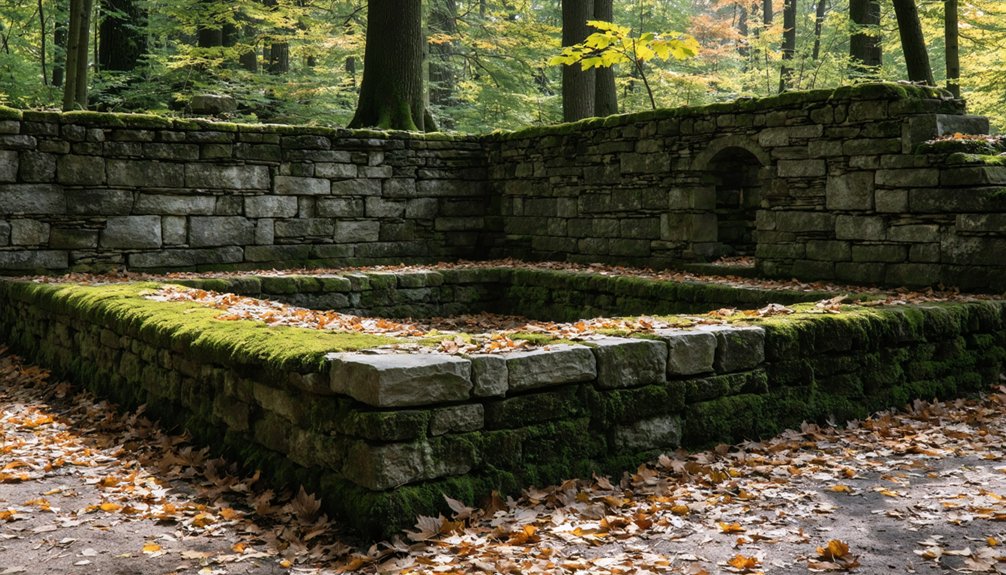
Although centuries have passed since Gay City’s abandonment, the ghost town’s structural remains persist throughout Connecticut’s woodland landscape.
You’ll discover preserved foundations of homes and mills emerging from the forest floor, with stone walls mapping out the village’s original layout. The ruins paint a picture of what was once a bustling industrial settlement known as Factory Hollow.
- Stone cellars and chimneys mark where wooden buildings once stood
- A thrice-burned textile mill foundation serves as the park’s most significant ruin
- Historic charcoal pits appear as depressions scattered across abandoned landscapes
As you explore the hiking trails, you’ll encounter the old cemetery with its weathered tombstones, while agricultural stone walls guide your journey through this time-frozen settlement, offering glimpses into 18th and 19th-century rural life.
From Ghost Town to State Park Paradise
Since its establishment as Connecticut’s 54th state park in 1946, Gay City has transformed from an abandoned mill town into a thriving 1,569-acre recreational paradise.
Today, you’ll find over 21 miles of trails perfect for hiking, biking, and winter sports like snowshoeing. The park’s diverse outdoor programs cater to all seasons, with swimming and fishing during warmer months and cross-country skiing when snow blankets the landscape.
Experience every season at Gay City, from summer swimming and trail hiking to winter cross-country skiing across 21 miles of scenic paths.
Under Connecticut DEEP’s management, park activities continue expanding through public-private partnerships and new initiatives.
The planned $100,000 beach upgrade and enhanced camping facilities demonstrate ongoing development. While enjoying modern amenities, you can still discover the town’s history through preserved stone foundations and tombstones along the trails, connecting you to Gay City’s industrial past while experiencing its natural rebirth.
Historical Legacy and Modern-Day Adventures

While exploring Gay City’s trails today, you’ll encounter remnants of its complex past, from stone foundations of the original 1796 settlement to the haunting ruins of three ill-fated mills.
The community’s journey from religious isolation to eventual abandonment is etched in every cellar hole and crumbling wall you’ll discover along the 10-mile trail network.
- Explore the former Methodist settlement’s stone foundations, where 25 families once sought refuge from mainstream society
- Visit mysterious mill ruins that tell tales of devastating fires and industrial collapse
- Wander through historic graveyards that reveal the community dynamics of this once-thriving village
The park’s 1,500+ acres preserve not just a ghost town’s physical remains, but also the compelling story of a community that struggled between piety and prosperity before fading into history.
Frequently Asked Questions
What Happened to Elijah Andrus After Founding the Settlement?
You won’t find clear records of Andrus’ legacy after 1800, as he mysteriously abandoned the settlement due to internal challenges. Historical documents don’t track his whereabouts following his sudden departure.
Were Any Artifacts From the Original Settlers Recovered From the Site?
Like scattered breadcrumbs from the past, you’ll find stone foundations and mill ruins, but there aren’t documented artifact discoveries beyond these structural remains. The site’s preservation focused on keeping ruins intact.
How Many People Lived in Gay City During Its Peak?
Based on historical records and population estimates from the 25 families who lived there, you’ll find that approximately 100-150 people resided in the settlement during its peak period.
What Caused the Methodist Sect to Initially Flee From Hartford?
While you embraced Methodist practices and alcohol in worship, Hartford’s dominant Congregationalists persecuted your sect for these liberal religious customs, forcing you to flee and seek freedom elsewhere in 1796.
Are Overnight Camping or Paranormal Investigations Permitted in the Park?
You’ll need permits for youth group camping only – general overnight camping isn’t allowed. While the park’s ruins attract paranormal enthusiasts, there aren’t specific guidelines for ghost investigations in the regulations.
References
- https://sites.psu.edu/rileygallagherpassionblog/2020/10/12/gay-city/
- https://boltoncthistory.org/gay-city-or-factory-hollow/
- https://www.theyankeexpress.com/2022/06/23/403723/gay-city-state-park-haunted-ghost-town-part-1
- https://www.damnedct.com/gay-city-hebron/
- https://www.atlasobscura.com/places/gay-city-state-park
- https://www.islands.com/1890369/connecticut-underrated-gay-city-state-park-trrails-remains-abandoned-town-dark-history/
- https://ghostofnewengland.com/gay-city-mill-village/
- https://lostglastonbury.com/2019/06/04/gay-city-road/
- https://en.wikipedia.org/wiki/Gay_City_State_Park
- https://www.ctmq.org/gay-city-state-park-intro/
